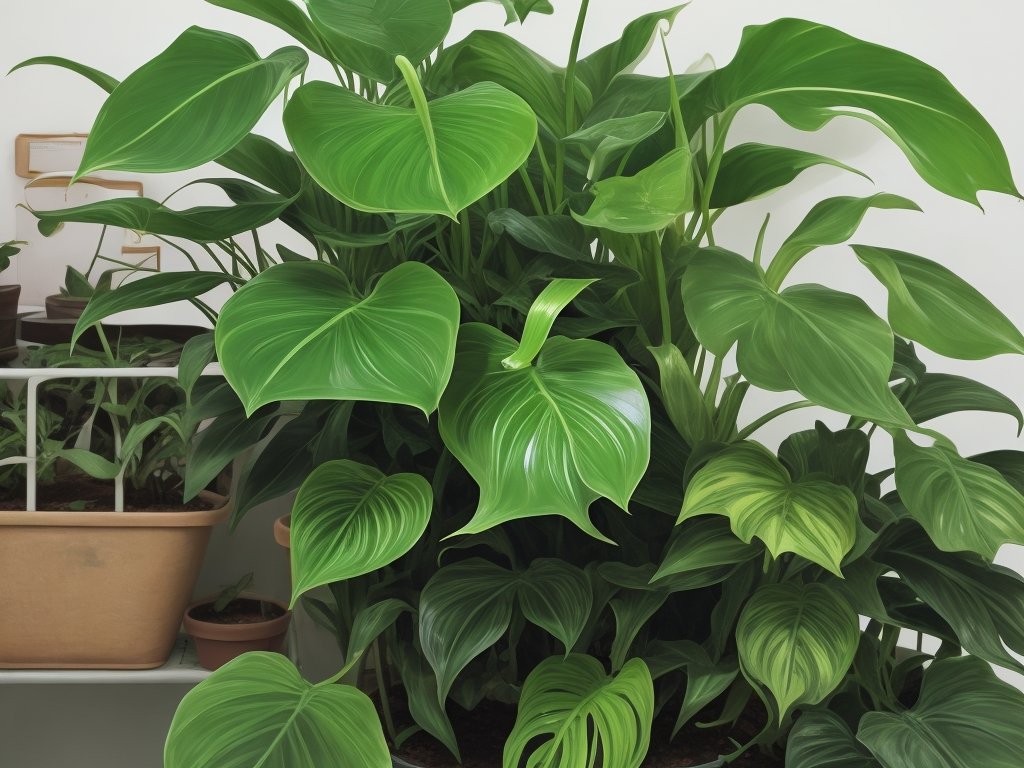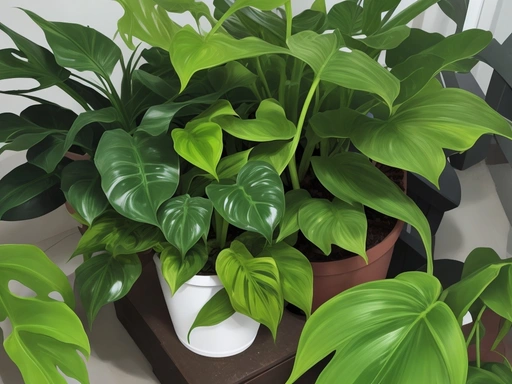Philodendron Soil Moisture Levels: Enhancing Your Indoor Oasis
Key Takeaways:
- Philodendrons prefer moist but not waterlogged soil.
- Overwatering can lead to root rot and other diseases in Philodendrons.
- Maintaining proper soil moisture is key to the health and growth of Philodendron plants.
- Regularly checking and adjusting soil moisture levels is important for Philodendron care.
Welcome to our blog where we dive deep into the fascinating world of Philodendrons and their soil moisture levels. Are you a plant lover looking to unlock the secrets of keeping your Philodendrons thriving?
Well, you’ve come to the right place! In this article, I’ll be sharing valuable insights on why soil moisture is crucial for the health of your Philodendrons.
We’ll explore the ideal moisture levels, signs of overwatering and underwatering, and the factors that can affect soil moisture. Plus, I’ll provide you with expert tips on maintaining optimal moisture levels and troubleshooting common issues.
So, let’s get started on this exciting journey to become a Philodendron pro!
| Moisture Level | Description |
| Dry | Soil feels dry to the touch, no visible moisture |
| Slightly Moist | Soil feels slightly damp to the touch, not completely dry |
| Moist | Soil feels consistently damp, but not overly wet |
| Wet | Soil feels saturated, excess water may be present |
Understanding Philodendron Soil Moisture Levels
Understanding Philodendron soil moisture levels is essential for the health and well-being of your plants.
Why is soil moisture important for Philodendrons?
Soil moisture is important for Philodendrons because it directly affects their overall health and growth.
Philodendrons need consistent moisture in their soil to thrive.
Proper soil moisture ensures that the roots can absorb nutrients and water efficiently.
It also helps in maintaining their lush green foliage and prevents issues like dehydration or root rot.
Adequate soil moisture levels are essential for optimum plant growth and vitality.
Ideal soil moisture levels for Philodendrons
The ideal soil moisture levels for Philodendrons is to keep the soil evenly moist, but not soggy. The top inch of soil should be slightly dry before watering again.
Avoid letting the soil dry out completely or sitting in waterlogged conditions.
Regularly check the soil moisture and adjust watering accordingly.
Signs of overwatered Philodendrons
Signs of overwatered Philodendrons include yellowing or wilting leaves, root rot, mold or fungi growth in the soil, and a foul odor.
The soil may also feel constantly wet or soggy.
For a quick check, insert your finger into the soil to feel its moisture level.
Signs of underwatered Philodendrons
Underwatered Philodendrons may show the following signs:
- Wilting leaves: The leaves may appear droopy, limp, or shriveled.
- Dry soil: Check the moisture level of the soil by touching it with your finger. A lack of moisture indicates underwatering.
- Yellowing leaves: The lower leaves may turn yellow and eventually brown if the plant is not receiving enough water.
- Slow growth: Underwatered Philodendrons may experience stunted growth and have fewer new leaves.
- Leaf curling: In an attempt to conserve moisture, the leaves may curl inward.
Remember, it’s important to find the right balance and provide adequate water for your Philodendron to thrive.
Factors affecting soil moisture levels
Factors affecting soil moisture levels in Philodendrons include:
- Environmental conditions: Temperature, humidity, and airflow can impact how quickly soil dries out or retains moisture.
- Pot size and drainage: Larger pots hold more water, while pots with good drainage allow excess water to escape.
- Watering frequency: Overwatering or underwatering can lead to imbalances in soil moisture levels.
- Soil type and composition: Different soil types, such as sandy or loamy soils, retain different amounts of moisture.
- Plant size and growth stage: Larger plants require more water, while younger plants may need less frequent watering.
- Sunlight exposure: More sunlight can cause soil to dry out faster, while less sunlight can slow down evaporation.
- Root health: Healthy roots can absorb water efficiently, while damaged or rotting roots may struggle to take in moisture.
How to check soil moisture levels in Philodendrons
To check the soil moisture levels in Philodendrons, you can use the following methods:
- Finger Test: Insert your finger about an inch into the soil near the plant’s base. If the soil feels dry at this depth, it may be time to water. If it feels moist, you can wait a bit longer.
- Moisture Meter: Use a moisture meter to get a more accurate reading of the soil moisture. Simply insert the probe into the soil and check the reading on the meter. It will indicate whether the soil is dry, moist, or wet.
- Visual Inspection: Observe the soil’s appearance and texture. Dry soil will appear light in color and will feel powdery. On the other hand, moist soil will look darker and feel slightly damp. Wet soil will be saturated and may have pooling water.
Remember, it’s essential to check the moisture levels regularly to avoid overwatering or underwatering your Philodendrons.

Maintaining Optimal Soil Moisture Levels for Philodendrons
Maintaining optimal soil moisture levels for Philodendrons is essential for their health and growth.
Watering frequency for Philodendrons
The watering frequency for Philodendrons depends on various factors such as the type of Philodendron, the size of the plant, the potting mix, and the environment it is in. As a general guideline, water your Philodendron when the top inch of the soil feels dry to the touch.
Be mindful not to overwater or let the soil dry out completely.
Regularly check the moisture levels to ensure you’re giving your Philodendron the right amount of water.

Best time to water Philodendrons
The best time to water Philodendrons is when the top inch of the soil feels dry to the touch. Water thoroughly until the excess water drains out of the bottom of the pot.
Avoid watering in the evening to prevent the plant from sitting in damp soil overnight.

Proper watering techniques for Philodendrons
To properly water your Philodendron, you should wait until the top inch of soil feels dry before watering again. When watering, make sure to thoroughly saturate the soil until water drains from the bottom of the pot.
Avoid overwatering, as this can lead to root rot.
Additionally, it’s important to use well-draining soil and a pot with drainage holes to prevent waterlogged roots.
Choosing the right pot and soil for Philodendrons
Choosing the right pot and soil for Philodendrons is important. Use pots with drainage holes to prevent waterlogging.
A well-draining soil mixture is key, like a blend of peat moss, perlite, and potting soil.
Avoid heavy or compacted soil that can hold too much moisture.
Using moisture meters and other tools for monitoring soil moisture
Using a moisture meter is a great way to monitor soil moisture levels for your Philodendrons.
These tools provide instant readings and help prevent overwatering or underwatering.
Additionally, you can also use your finger to perform a simple moisture test.
Insert your finger into the soil and if it feels dry up to the first knuckle, it’s time to water.
If it still feels moist, hold off on watering.
Troubleshooting Philodendron Soil Moisture Issues
Having trouble with your Philodendron’s soil moisture?
Here’s how to troubleshoot the issues.
Remedies for overwatered Philodendrons
To remedy overwatered Philodendrons, the first step is to stop watering them immediately. Allow the soil to dry out completely before watering again.
If the roots are rotting, gently remove the Philodendron from its pot, trim away any affected roots, and repot it in fresh, well-draining soil.
Provide proper drainage, ensure adequate airflow, and avoid overwatering in the future.
Remedies for underwatered Philodendrons
To remedy underwatered Philodendrons, start by thoroughly watering the plant. Ensure the water reaches the root zone.
If the soil is too compacted, loosen it with a fork.
Grouping plants together can increase humidity, or mist the leaves regularly. Adjust the watering schedule to prevent future underwatering.
Dealing with root rot in Philodendrons
To deal with root rot in Philodendrons, you need to take prompt action.
Firstly, carefully remove the affected plant from its pot, and gently shake off any loose soil.
Secondly, trim away any soft, mushy roots with clean, sharp scissors.
Thirdly, allow the plant to dry out slightly before repotting it in fresh, well-draining soil.
Finally, adjust your watering routine and make sure to provide adequate drainage to prevent future incidences of root rot.
Remember, prevention is key in keeping your Philodendron healthy and thriving.
Preventing moisture-related diseases and pests
To prevent moisture-related diseases and pests in your Philodendrons, it’s important to maintain proper soil moisture levels. Avoid overwatering, as this can lead to root rot and fungal diseases.
Ensure good drainage in your pots and use well-draining soil.
Avoid standing water and stagnant conditions. Regularly monitor soil moisture levels and adjust watering accordingly.
Keep your plants in a well-ventilated area to prevent excessive humidity.
Lastly, maintain a clean and tidy environment to prevent the buildup of pests and diseases.

Frequently Asked Questions about Philodendron Soil Moisture Levels
Can Philodendrons tolerate drought?
Yes, Philodendrons can tolerate some level of drought.
They are adaptable plants that can survive in periods of low water availability.
However, prolonged drought can be detrimental to their health.
It’s important to find a balance and provide occasional watering to prevent extreme moisture stress.
How often should I water my Philodendron?
Water your Philodendron when the top inch of soil feels dry to the touch. Stick your finger into the soil to check for moisture.
Ensure thorough watering, allowing excess water to drain out the bottom of the pot.
Avoid overwatering, as it can lead to root rot.
What type of soil is best for Philodendrons?
The best soil for Philodendrons is a well-draining potting mix that retains some moisture while allowing excess water to flow out. A mix of peat moss, perlite, and vermiculite is commonly used.
Adding some organic matter can also help retain moisture.
Avoid heavy clay soils that can hold too much water and cause root rot.
Can I use a moisture meter for all types of Philodendrons?
Yes, you can use a moisture meter for all types of Philodendrons.
A moisture meter is a handy tool that helps you accurately determine the soil moisture levels in your plants.
It can be used for any Philodendron variety to ensure you’re providing the right amount of water based on their specific needs.
Just insert the probe into the soil and check the moisture reading on the meter.
Simple and convenient!
Final Verdict
Understanding and maintaining the proper soil moisture levels for Philodendrons is crucial for their overall health and growth.
Overwatering can lead to root rot and other moisture-related issues, while underwatering can cause dehydration and stunted growth.
Factors such as humidity, pot size, and soil type should be considered when determining watering frequency and techniques.
Regularly monitoring soil moisture levels with tools like moisture meters can help prevent moisture-related problems.
By following these guidelines, you can ensure that your Philodendrons thrive in optimal conditions and continue to beautify your space for years to come.







